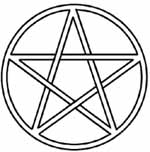
Gawain's Pentangle

It may strike modern readers as odd that Gawain sports a symbol now commonly associated with Neo-Paganism, witchcraft, the occult and bad death-metal, but the poem reminds us that the symbol was, at least as late c. 1400, a Christian symbol.
It may also identify Gawain as -- or at least loosely associate him with -- a Knight Templar: an order of warrior-knights who gained prominence during the early Crusades and named for their role in protecting Christian pilgrims who wanted to visit Jerusalem. This connection also reminds us the Pentangle was associated with Solomon's Temple, or, the Temple, as Jews today still refer and worship it.
But the Pentagram was a significant symbol going even further back, including the Pythagoreans, who so deeply influenced Plato, and even the Sumerians, the oldest civilization and father of Gilgamesh.
Most interestingly, however, is that is was used as the city symbol of Jerusalem from 300-150 BCE.
It continues today, of course, as the symbol for law and order (police badge) or the sign of highest military decoration.
The shift from Christian to "occult" status may be linked to the political falling out between the Templar and Pope Clement V, who disbanded the Order in 1312. If so, Sir Gawain And The Green Knight (c. 1400) reminds us that such demonizing of the symbol had yet to reach N. England, or maybe the British author employs it as a middle finger (or two-fingers...or five?).
Much like the name "Lucifer" in the Old Testament or even the prominence of Christmas trees in modern Christian celebrations, this short history of the pentangle should remind us that all beliefs have a history, and "truths" we take for granted today (Lucifer is Satan, Christmas trees are, uh, "Christmas" trees, the pentangle is Satanic etc) were probably viewed entirely different -- perhaps even exactly the opposite of -- the way we view them now.
Much more here: New World Encyclopedia